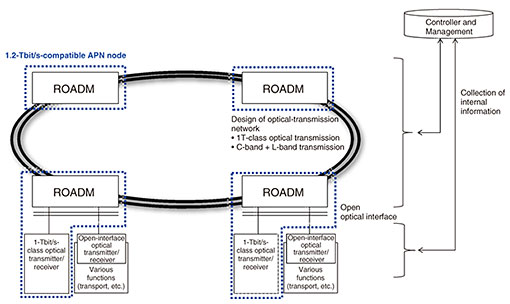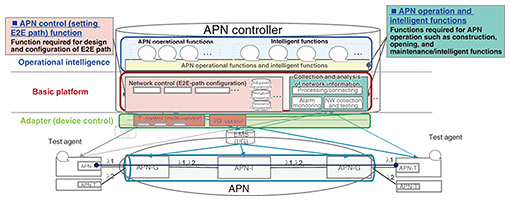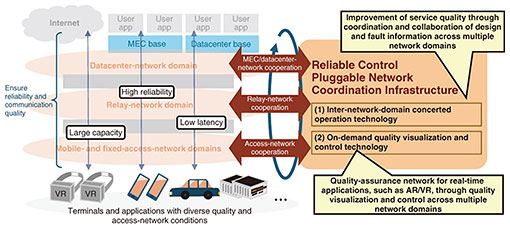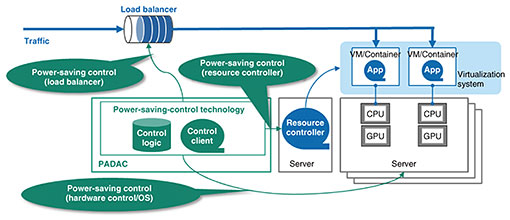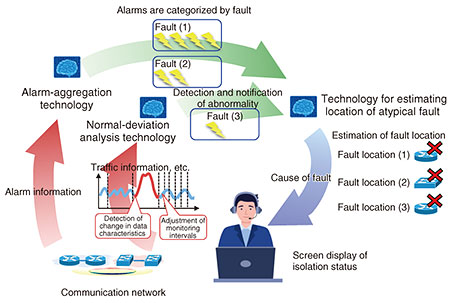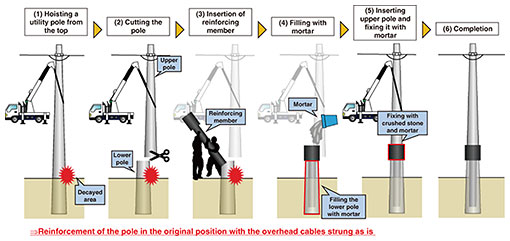 |
|||||||
|
|
|||||||
|
Feature Articles: Frontlines of IOWN Development—Development of IOWN Hardware and Software and Social Implementation Activities Vol. 23, No. 7, pp. 28–35, July 2025. https://doi.org/10.53829/ntr202507fa3 Efforts to Develop Network Technologies for Practical Application of IOWNAbstractThe Innovative Optical and Wireless Network (IOWN) concept aims to implement an infrastructure for networks and information processing that provides high-speed, large-capacity communications and vast computing resources by using innovative technologies centered on optics. NTT Network Innovation Center is investigating the entire communications network, including infrastructure, access networks, core networks, network services, and operations, to apply the IOWN concept in society. This article outlines such activities of NTT Network Innovation Center. Keywords: APN, network-service infrastructure, access-network infrastructure 1. Efforts of NTT Network Innovation Center towards practical use of IOWNThe aim of the concept of the Innovative Optical and Wireless Network (IOWN) is to implement an infrastructure for networks and information processing that provides high-speed, large-capacity communications and vast computing resources by using innovative technologies centered on optics. To implement IOWN and apply it practically in society, NTT Network Innovation Center is investigating the entire communications network including infrastructure, access networks, core networks, network services, and operations. The environment surrounding network-related research and development (R&D) is undergoing major changes, which include ongoing trends such as increasing data-traffic flow due to advances in artificial intelligence (AI), more-frequent and severe natural disasters, and growing attention on carbon neutrality and the environment. Cyber attacks and failures on telecommunications infrastructure are also having a greater impact on people’s lives and social activities, competition in network quality is intensifying as typified by the mobile business, and innovation is occurring in AI/digital technology as typified by generative AI. In light of these changes, NTT Network Innovation Center is striving to accelerate the early practical application of the All-Photonics Network (APN)—which provides end-to-end (E2E) optical-wavelength paths—; enhance network service infrastructure and improve sustainability; promote autonomy in network operations and expand the scope of application of AI technology; and enhance access-network infrastructure and make operations smarter. 2. Efforts to accelerate early practical application of the APNAs one of the main elemental technologies that constitute IOWN, the APN aims to achieve unprecedented low-power-consumption, high-speed, large-capacity, and low-latency transmission. Regarding the configuration of the APN, photonics-based technology is implemented from terminals to networks and optical-wavelength paths are provided from E2E through a wavelength-routing network. Among the elemental technologies of IOWN, the early commercialization has been promoted for the APN, and the first commercial service was launched in 2023 as APN IOWN 1.0. At NTT Network Innovation Center, we are supporting further development of the APN by developing systems to achieve higher-speed and larger-capacity communications while providing lower latency, higher security, and lower power consumption. We are developing APN nodes capable of transmitting optical signals at 1 Tbit/s per wavelength, which will significantly improve power efficiency and expand transmission capacity, as well as developing products such as a delay-managed network system, which manages communication delays from E2E and enables low-latency accommodation and advanced delay control of various signals, and a secure optical-transport system, which integrates quantum-safe cryptography functionality into open optical-transport equipment to securely connect bases while maintaining optical transmission. When providing optical paths, keeping the paths up and running in the manner of a dedicated line is costly, and before the paths are first opened, it takes time to design and set them up. It is thus necessary to enable on-demand, flexible control of optical paths. To meet that need, we are also developing an APN controller that will reduce maintenance and operating costs through integrated management and automated/on-demand operation of the APN. These APN nodes and this APN controller are explained in the following sections. 3. APN nodes compatible with 1-Tbit/s-class optical-signal transmissionRegarding APN nodes capable of transmitting optical signals at 1 Tbit/s, transmission capacity is expanded by using cutting-edge optical-communications devices and the latest technologies. At the same time, system power consumption is significantly reduced by using a system configuration that separates the reconfigurable optical add/drop multiplexer (ROADM) and optical transceiver by means of an open optical interface and eliminates optical-to-electrical conversion (Fig. 1).
Under the assumption that dense wavelength-division multiplexing and digital coherent technology are used, transmission capacity can be expanded by multiplexing optical signals of approximately 1 Tbit/s per wavelength. By separating the ROADMs from the optical transmitters/receivers and specifying an open optical interface, it is possible to use various optical transmitters/receivers to connect remote locations with optical signals as is. These APN nodes will use the world’s-most-advanced digital-signal processor to increase the modulation rate and modulation level of optical signals. It will thus be possible to achieve transmission capacity of 800 Gbit/s over long distances and 1.2 Tbit/s over short distances. Controlling optical noise and optical-signal distortion makes it possible to design stable transmission of high-speed optical signals. By implementing optical and system designs that support both the C-band and L-band, which were not available for conventional networks, it is also possible to double transmission capacity. By adopting the OpenROADM Multi-Source Agreement (MSA) and OpenZR+ MSA standards, it is possible to improve interoperability in multi-vendor environments and achieve an open optical interface. 4. APN controller that enables integrated management and automated/on-demand operation of the APNThe APN controller provides functions for setting and maintaining E2E optical paths in a multi-vendor environment. It consists of an APN control (E2E-path setting) function and APN operation and intelligence functions [1] (Fig. 2). The APN control function enables design and setting of E2E paths in a multi-vendor environment and seamlessly controls intermediate transmission devices (APN-I/Gs) and transceivers (APN-Ts). The APN operation and intelligence functions collect E2E-path information and monitor alarms. They also prevent failures by visualizing network information across the optical and service layers and using performance monitoring.
The APN controller is composed of three layers: basic platform, adapter (for device control), and operational intelligence. It executes network control and information collection and analysis, adjusts configuration parameters and control scenarios, and centrally collects and analyzes network information. It thus enables efficient configuration and maintenance of paths in a multi-vendor environment. 5. Initiatives to enhance network service infrastructure and improve sustainabilityIn the era of 6G (6th-generation mobile communication system) combined with IOWN, it will be vital to provide high-performance communications seamlessly via E2E without requiring users to be aware of various access methods. To provide high-quality, highly functional communications that meet the diverse needs of users regardless of location or usage across IOWN, NTT Network Innovation Center is promoting technological development for advanced control and management by integrating mobile and fixed networks, added network value that supports extended reality and the metaverse, and added power-saving value and security for systems. We are specifically promoting the development of the following four exemplary products: (i) the Reliable Control Pluggable Network Coordination Infrastructure, which ensures reliability and communication quality across multiple network domains such as access networks and datacenter networks; (ii) a communications platform for metaverse services; (iii) server power-saving technology that achieves power savings by effectively using optimized control of load placement and infrastructure settings from the perspective of power consumption and power-saving mechanisms of accelerators and central processing units (CPUs); and (iv) multi-radio proactive-control technology that creates a wireless communication environment that tracks and anticipates complex and changing usage environments and requirements. The Reliable Control Pluggable Network Coordination Infrastructure and server power-saving technology are explained in more detail in the following sections. 6. Reliable Control Pluggable Network Coordination Infrastructure that ensures reliability and communication quality across network domainsAs the role of telecommunications carriers in regard to social infrastructure expands, it is necessary to devise mechanisms to ensure reliability and quality across multiple network domains such as access networks and datacenter networks. New use cases, such as multi-access edge computing (MEC) provided by telecommunications carriers and augmented reality (AR)/virtual reality (VR) services using datacenters, are becoming more widespread, and it is necessary to select the appropriate access method (i.e., mobile access or fixed access). To ensure reliability and communication quality, it is necessary to quickly recover from issues that impact across multiple network domains and manage resources and visualize quality across network domains to guarantee E2E service quality. To meet these requirements and ensure reliability and communication quality across multiple network domains, the Reliable Control Pluggable Network Coordination Infrastructure is provided [2] (Fig. 3).
The infrastructure consists of two technologies: inter-network-domain concerted operation and on-demand quality visualization and control. The former enables rapid recovery from failures by coordinating configurations and operations across multiple network domains. When a failure occurs that affects multiple network domains, two functions are provided: inter-domain suspected-event inference, which shortens the time to recovery by analyzing alerts across domains and inferring suspected events, and inter-domain policy-information sharing, which centrally manages the necessary communication-control policies—regardless of whether the access method is mobile or fixed—thus reduces the lead time for network provision. The latter enables quality assurance of user communications across domains. It provides three functions: on-demand quality monitoring, which dynamically monitors the network and changes the quality-monitoring targets to keep up with changes in the configuration of terminals, servers, and applications according to the communication quality required by the user; inter-domain quality assessment and coordination, which estimates quality degradation and recommends recovery measures on the basis of quality metrics obtained from each domain; and access-quality control, which applies controls to ensure quality by using the quality-control capabilities of the access network. 7. Energy saving for server platforms through optimized control of load placement and platform settings from the perspective of power consumptionAs IP (Internet Protocol) traffic increases exponentially, the power consumed by that traffic and the associated data processing is becoming a major issue. In particular, the demand for AI and machine-learning services is growing rapidly, and it is urgently required to reduce the power consumption of the servers that run those services. Regarding IOWN, NTT proposes a disaggregated computer with which distributed computing devices, such as CPUs and graphics processing units (GPUs), can be flexibly combined via optical-fiber lines. With a disaggregated computer, which has a huge number of device-combination patterns, power-aware dynamic allocation control (PADAC), a power-saving technology for server infrastructure, guides controlled devices to a power-efficient state and selects a highly efficient device to process requests (Fig. 4).
PADAC is implemented as a software-based control technology that can be introduced at low cost without modifying existing applications. One of the core technologies of PADAC is power-saving control of CPUs, which uses the sleep state (C-state) and performance state for power-saving functions that control CPUs. This control technology allocates processes to increase the number of CPU cores in the C-state (thus increasing the number of sleep cores) and prevent the C-state from being released (thus preventing release from sleep). This reduces power consumption while maintaining as much application performance as possible. By controlling virtualized systems by using resource controllers, such as Kubernetes and OpenStack, PADAC achieves effective power saving in multi-server environments. 8. Promoting autonomy in network operations and expanding the scope of applications of AI technologyAs the social impact of network failures grows, network operation is playing an increasingly important role. However, as networks become more diverse and complex, the extent to which they can be manually operated is becoming more limited. With that limitation in mind, at NTT Network Innovation Center, we are using AI technology to automate business processes, such as analyzing alarms and identifying fault locations, currently done by hand with the aim of autonomously responding to environmental changes such as the addition of new equipment or changes to the network configuration. Therefore, AI can autonomously and quickly recover network operation to an optimal state, even in the event of a disaster or failure, thus helping to address social issues. In the following section, maintenance AI technology enabling zero-touch operation is introduced. 9. Maintenance AI technology enabling zero-touch operationZero-touch operation in fault-response work requires AI technology that can execute complex processes, such as alarm-correlation analysis and fault-cause analysis, in place of maintenance personnel. It is important to establish highly accurate AI technology that can minimize the social impact of mistakes in fault-response work. To achieve zero-touch operation that meets these requirements and fully automates fault-response work, we are researching and developing highly accurate maintenance AI technology that incorporates the expertise of maintenance personnel [3] (Fig. 5).
We are developing the network (NW)-AI functions: deviation analysis during normal operation, which promptly detects unusual events that have not yet raised alarms by analyzing large volumes of equipment logs and various metrics; alarm aggregation, which facilitates analysis by classifying and aggregating large volumes of alarms by fault, speeding up fault response, and preventing faults from being overlooked; estimating atypical-fault location, which estimates and presents the location of the fault in a manner that enables maintenance personnel to speed up their decisions and take action; and coordination scenario management for coordinating the aforementioned NW-AI functions. We are also investigating AIOps-GW (artificial intelligence operations-gateway) technology, which detects AI errors and verifies the validity of the output from the same perspective as a maintenance worker, and semi-autonomous re-learning technology, which maintains the accuracy of AI by relearning on its own in response to deterioration in AI accuracy due to changes in the environment. Applying these technologies to the automation of monitoring tasks concerning carrier networks and cloud-datacenter networks will improve the efficiency and reliability of network operations. 10. Initiatives to enhance access-network infrastructure and make operations smarterIn conjunction with the above-mentioned efforts toward practical use of the APN, demands for smarter construction, operation, and maintenance of the access-network infrastructure that serves as the foundation for the APN are growing. Accordingly, NTT Network Innovation Center is developing technologies that will contribute to strengthening the access-network infrastructure and increasing its speed and capacity to expand coverage, making the maintenance and inspection work of external telecommunications equipment smarter, and further improving work efficiency and safety through new construction methods and technologies. We are promoting the following technical developments: multi-core optical-fiber cables that use space-division multiplexing to address the issue of increasing data traffic and reduce facility construction costs; smart-engineering technology for fundamentally reforming the construction of external telecommunications facilities and reducing the burden of manual construction through construction automation and labor saving; and digital transformation—by using point cloud and image data—of maintenance and management work on external telecommunications facilities. A ground-reinforcement method and new-material utility poles are introduced as one of these smart-engineering technologies in the following section. 11. Smart-engineering technology (ground-reinforcement method and new-material utility poles)In conjunction with the declining birthrate and aging population, the number of construction workers involved in inspection and construction of infrastructure facilities is decreasing. However, as the total amount of utility-pole equipment remains constant but continues to deteriorate, technology for labor-saving construction of utility poles that ensures safety is required. As for replacement work of corroded steel-pipe poles, we therefore established a ground-reinforcement method that enables reinforcement in the original pole in its original position while leaving the overhead cables strung as is (Fig. 6). We also developed a utility-pole material that is lighter than current materials to reduce the labor burden of manually erecting utility poles in tight spaces where use of heavy machinery is impractical.
Regarding the ground-reinforcement method, we have developed (i) reinforcing members that ensure strength equal to or greater than that of sound steel-pipe utility poles and (ii) a method that uses pole-holding tools that enable safe work. As for new-material utility poles, we have developed a structure that is lightweight but has strength equal to or greater than that of steel-pipe utility poles by using different new materials (i.e., not concrete or steel) and optimizing the winding angle and cross-sectional shape of the materials in a layered structure. These technologies will reduce the labor required for constructing utility poles and improve safety while contributing to rapid recovery in the event of a natural disaster. 12. ConclusionAs the organization responsible for implementing and commercializing IOWN in the network field, NTT Network Innovation Center will continue to monitor global markets and trends while continuing to work on technological development from a medium- to long-term perspective. References
|
|||||||









